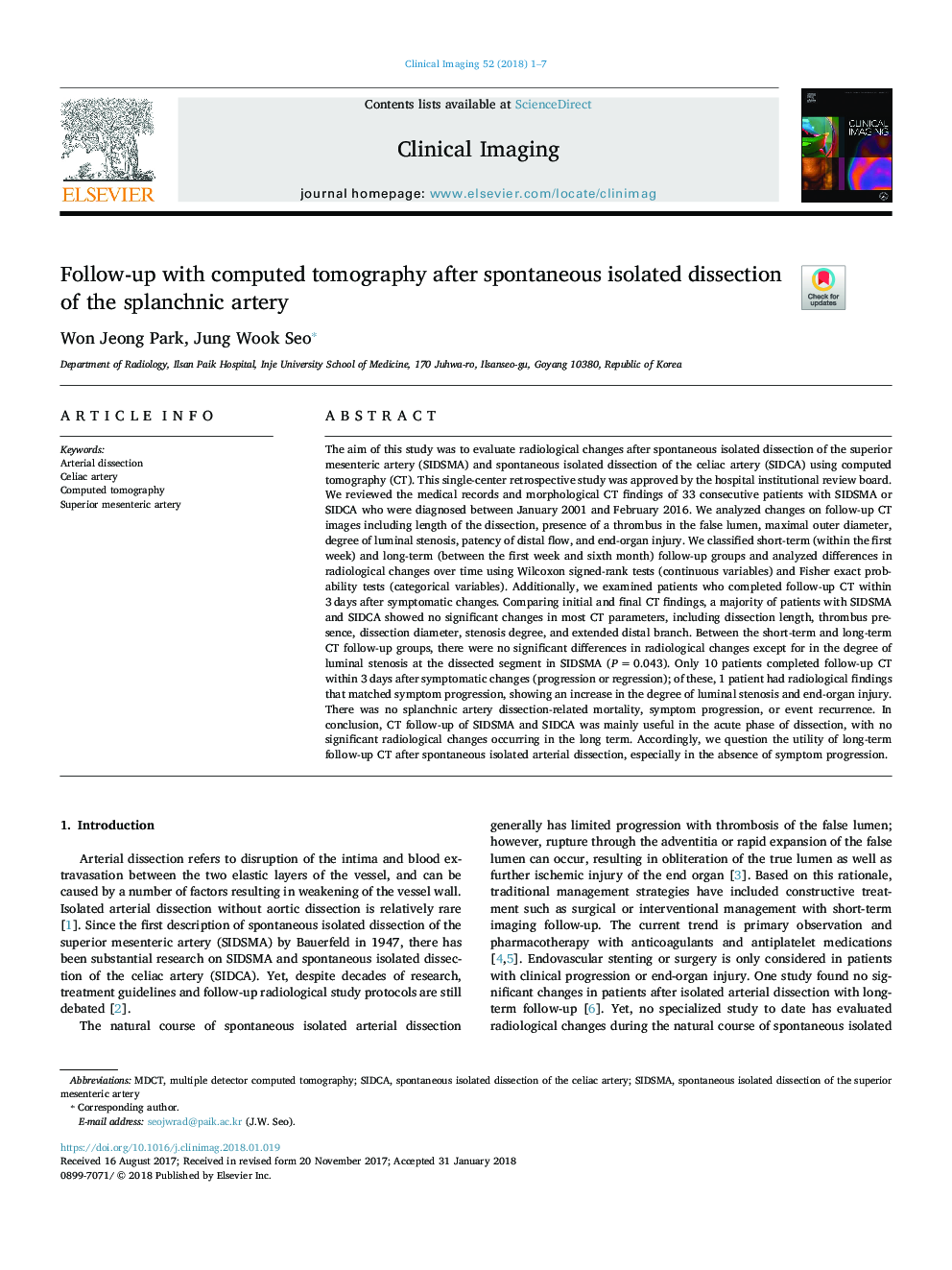| کد مقاله | کد نشریه | سال انتشار | مقاله انگلیسی | نسخه تمام متن |
|---|---|---|---|---|
| 8821245 | 1609583 | 2018 | 7 صفحه PDF | دانلود رایگان |
عنوان انگلیسی مقاله ISI
Follow-up with computed tomography after spontaneous isolated dissection of the splanchnic artery
ترجمه فارسی عنوان
پیگیری با توموگرافی کامپیوتری پس از جدا شدن انشعاب جداگانه انسداد شریان اسپلنیکیک
دانلود مقاله + سفارش ترجمه
دانلود مقاله ISI انگلیسی
رایگان برای ایرانیان
کلمات کلیدی
موضوعات مرتبط
علوم پزشکی و سلامت
پزشکی و دندانپزشکی
رادیولوژی و تصویربرداری
چکیده انگلیسی
The aim of this study was to evaluate radiological changes after spontaneous isolated dissection of the superior mesenteric artery (SIDSMA) and spontaneous isolated dissection of the celiac artery (SIDCA) using computed tomography (CT). This single-center retrospective study was approved by the hospital institutional review board. We reviewed the medical records and morphological CT findings of 33 consecutive patients with SIDSMA or SIDCA who were diagnosed between January 2001 and February 2016. We analyzed changes on follow-up CT images including length of the dissection, presence of a thrombus in the false lumen, maximal outer diameter, degree of luminal stenosis, patency of distal flow, and end-organ injury. We classified short-term (within the first week) and long-term (between the first week and sixth month) follow-up groups and analyzed differences in radiological changes over time using Wilcoxon signed-rank tests (continuous variables) and Fisher exact probability tests (categorical variables). Additionally, we examined patients who completed follow-up CT within 3â¯days after symptomatic changes. Comparing initial and final CT findings, a majority of patients with SIDSMA and SIDCA showed no significant changes in most CT parameters, including dissection length, thrombus presence, dissection diameter, stenosis degree, and extended distal branch. Between the short-term and long-term CT follow-up groups, there were no significant differences in radiological changes except for in the degree of luminal stenosis at the dissected segment in SIDSMA (Pâ¯=â¯0.043). Only 10 patients completed follow-up CT within 3â¯days after symptomatic changes (progression or regression); of these, 1 patient had radiological findings that matched symptom progression, showing an increase in the degree of luminal stenosis and end-organ injury. There was no splanchnic artery dissection-related mortality, symptom progression, or event recurrence. In conclusion, CT follow-up of SIDSMA and SIDCA was mainly useful in the acute phase of dissection, with no significant radiological changes occurring in the long term. Accordingly, we question the utility of long-term follow-up CT after spontaneous isolated arterial dissection, especially in the absence of symptom progression.
ناشر
Database: Elsevier - ScienceDirect (ساینس دایرکت)
Journal: Clinical Imaging - Volume 52, NovemberâDecember 2018, Pages 1-7
Journal: Clinical Imaging - Volume 52, NovemberâDecember 2018, Pages 1-7
نویسندگان
Won Jeong Park, Jung Wook Seo,
